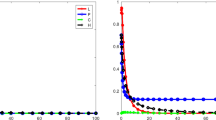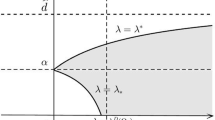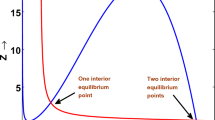Abstract
This paper deals with the dynamics of a prey-dependent two-species model, associating the Holling type II response function. We incorporate the prey refuge to the system with additional food supplement to self-competitive predator. We have found three ecologically significant equilibrium points as well as discussed their stability, instability conditions. The obtained results suggest that the coexisting equilibrium point can go through a Hopf bifurcation for some suitable value of prey refuge. Numerical simulations are performed to support all the analytical findings and to investigate the effects of additional food and self-interactions among predators for various densities of prey refuge. It can be observed that additional food supports coexisting behavior while intraspecific competition does not enhance coexistence so much but reducing the predator population, supports a stable solution. Although a very strong prey refuge forces the predators to extinct in both cases. Moreover, a comparison of four food web models has been performed to elaborate significantly the effects of prey refuge, additional food, and self-competition, respectively, on the system dynamics. The results yield that the model can fairly illustrate a realistic environmental ecology of two interacting populations and may be useful for species conservation.








Similar content being viewed by others
References
Abrams PA (1990) The effects of adaptive behavior on the type-2 functional response. Ecology 71(3):877–885
Al-Khedhairi A (2009) The chaos and control of food chain model using nonlinear feedback. Appl Math Sci 3(12):591–604
Ali N, Haque M, Venturino E, Chakravarty S (2017) Dynamics of a three species ratio-dependent food chain model with intra-specific competition within the top predator. Comput Biol Med 85:63–74
Birkhoff G, Rota G (1982) Ordinary differential equations 1989. Ginn, Boston
Cantrell RS, Cosner C (2004) Spatial ecology via reaction–diffusion equations. Wiley, New York
Chen F, Chen L, Xie X (2009) On a Leslie–Gower predator–prey model incorporating a prey refuge. Nonlinear Anal Real World Appl 10(5):2905–2908
Cheney DL, Seyfarth RM, Fischer J, Beehner J, Bergman T, Johnson S, Kitchen DM, Palombit R, Rendall D, Silk JB (2004) Factors affecting reproduction and mortality among baboons in the Okavango Delta, Botswana. Int J Primatol 25(2):401–428
Das A, Samanta G (2018) Stochastic prey–predator model with additional food for predator. Phys A Stat Mech Appl 512:121–141
Ghorai S, Poria S (2016) Pattern formation and control of spatiotemporal chaos in a reaction diffusion prey–predator system supplying additional food. Chaos Solitons Fractals 85:57–67
Ghosh J, Sahoo B, Poria S (2017) Prey–predator dynamics with prey refuge providing additional food to predator. Chaos Solitons Fractals 96:110–119
Gupta R, Chandra P (2013) Bifurcation analysis of modified Leslie–Gower predator–prey model with Michaelis–Menten type prey harvesting. J Math Anal Appl 398(1):278–295
Hale J (1969) Ordinary differential equations, volume 20 of pure and applied mathematics. Krieger Publishing Company, Malabar, FL
Hallam TG, Levin SA (2012) Mathematical ecology: an introduction, vol 17. Springer, Berlin
Holling CS (1959) Some characteristics of simple types of predation and parasitism. Can Entomol 91(7):385–398
Hsu SB, Hwang TW, Kuang Y (2001) Global analysis of the Michaelis–Menten-type ratio-dependent predator–prey system. J Math Biol 42(6):489–506
Ji L, Wu C (2010) Qualitative analysis of a predator–prey model with constant-rate prey harvesting incorporating a constant prey refuge. Nonlinear Anal Real World Appl 11(4):2285–2295
Kar TK (2005) Stability analysis of a prey–predator model incorporating a prey refuge. Commun Nonlinear Sci Numer Simul 10(6):681–691
Kar T, Ghosh B (2012) Sustainability and optimal control of an exploited prey predator system through provision of alternative food to predator. BioSystems 109(2):220–232
Kot M (2001) Elements of mathematical ecology. Cambridge University Press, Cambridge
Matassa CM, Ewanchuk PJ, Trussell GC (2018) Cascading effects of a top predator on intraspecific competition at intermediate and basal trophic levels. Funct Ecol 32(9):2241–2252
Přibylová L (2018) Regime shifts caused by adaptive dynamics in prey–predator models and their relationship with intraspecific competition. Ecol Complex 36:48–56
Sahoo B, Poria S (2013) Disease control in a food chain model supplying alternative food. Appl Math Model 37(8):5653–5663
Sahoo B, Poria S (2014) The chaos and control of a food chain model supplying additional food to top-predator. Chaos Solitons Fractals 58:52–64
Skalski GT, Gilliam JF (2001) Functional responses with predator interference: viable alternatives to the Holling type II model. Ecology 82(11):3083–3092
Srinivasu P, Prasad B, Venkatesulu M (2007) Biological control through provision of additional food to predators: a theoretical study. Theor Popul Biol 72(1):111–120
Tripathi JP, Abbas S, Thakur M (2015) Dynamical analysis of a prey–predator model with Beddington–DeAngelis type function response incorporating a prey refuge. Nonlinear Dyn 80(1–2):177–196
Wiggins S, Mazel DS (1990) Introduction to applied nonlinear dynamical systems and chaos. Comput Phys 4(5):563–563
Wu S, Song Y (2019) Stability and spatiotemporal dynamics in a diffusive predator–prey model with nonlocal prey competition. Nonlinear Anal Real World Appl 48:12–39
Yu X, Yuan S, Zhang T (2018) About the optimal harvesting of a fuzzy predator–prey system: a bioeconomic model incorporating prey refuge and predator mutual interference. Nonlinear Dyn 94(3):2143–2160
Author information
Authors and Affiliations
Corresponding author
Ethics declarations
Conflict of interest
The authors declare that they have no conflict of interest.
Rights and permissions
About this article
Cite this article
Samaddar, S., Dhar, M. & Bhattacharya, P. Supplement of Additional Food: Dynamics of Self-Competitive Prey–Predator System Incorporating Prey Refuge. Iran J Sci Technol Trans Sci 44, 143–153 (2020). https://doi.org/10.1007/s40995-019-00804-3
Received:
Accepted:
Published:
Issue Date:
DOI: https://doi.org/10.1007/s40995-019-00804-3




